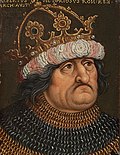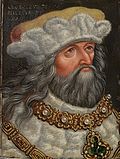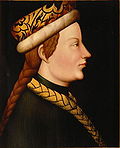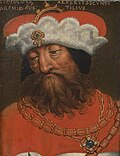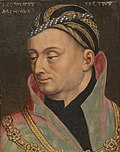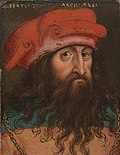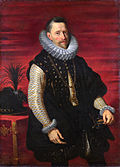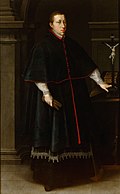| Name | Birth
Death | Reign | Ruling part | Consort | Notes |
|---|
 Leopold I the Illustrious Leopold I the Illustrious | c. 940
Son of Berthold of Nordgau or Arnulf, Duke of Bavaria
10 July 994
Würzburg
aged 53–54 | 21 July 976
10 July 994 | March of Austria | Richardis of Sualafeldgau
nine children | Founder of the Babenbergs. |
 Henry I the Strong Henry I the Strong | c. 965 (?)
First son of Leopold I and Richardis of Sualafeldgau
23 June 1018
aged 53–54 | 10 July 994
23 June 1018 | March of Austria | Unmarried | In his reign (996), the name Ostarrichi (later Osterreich, Austria) appeared for the first time to designate the land he ruled. |
 Adalbert I the Victorious Adalbert I the Victorious | c. 985
Third son of Leopold I and Richardis of Sualafeldgau
26 May 1055
Melk
aged 69–70 | 23 June 1018
26 May 1055 | March of Austria | Glismod of West-Saxony
no children
Frozza Orseolo
c.1025?
two children | Expanded his Bavarian margraviate to the Morava and Leitha rivers. |
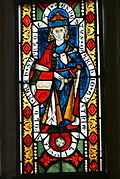 Ernest the Brave Ernest the Brave | 1027
Son of Adalbert I and Frozza Orseolo
10 June 1075
aged 47–48 | 26 May 1055
10 June 1075 | March of Austria | Adelaide of Eilenburg
1060
three children
Swanhilde of Ungarnmark
1072
no children | Expanded his Bavarian margraviate to the Morava and Leitha rivers. |
 Leopold II the Fair Leopold II the Fair | 1050
Son of Ernest and Adelaide of Eilenburg
12 October 1095
Gars am Kamp
aged 44–45 | 10 June 1075
12 October 1095 | March of Austria | Ida of Formbach-Ratelnberg
1065
eight children | Supported the Gregorian Reforms, and was an active opponent to Henry IV, Holy Roman Emperor during the Investiture Controversy. |
 Leopold III the Saint Leopold III the Saint | 1073
Gars am Kamp
Son of Leopold II and Ida of Formbach-Ratelnberg
15 November 1136
Klosterneuburg
aged 62–63 | 12 October 1095
15 November 1136 | March of Austria | Maria of Perg
no children
Agnes of Germany
1106
nineteen children | His second marriage brought the margraviate of Austria closer to the Imperial family, which raised the importance of the Babenbergs. Consequently, more royal rights were granted to Austria. |
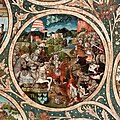 Adalbert II the Pious Adalbert II the Pious | 1106
First son of Leopold III and Agnes of Germany
9 November 1137
aged 30–31 | 15 November 1136
9 November 1137 | March of Austria | Adelaide of Poland
1128/29
no children
Hedwig of Hungary
1132
no children | Usually not counted as margrave, [1] despite being cited as so as early as 1119. Nevertheless, it's possible that he ruled for a year, or at least as claimant to his younger brother Leopold. If he ruled, he left no children. Knighted in 1125 [2] |
 Leopold IV the Generous Leopold IV the Generous | 1108
Third son of Leopold III and Agnes of Germany – 18 October 1141
Niederalteich
aged 32–33 | 9 November 1137
18 October 1141 | March of Austria | Maria of Bohemia
28 September 1138
no children | Also Duke of Bavaria, title given to him after his struggles with the House of Welf. |
 Henry II Jasomirgott [3] Henry II Jasomirgott [3] | 1107
Second son of Leopold III and Agnes of Germany
13 January 1177
Vienna
aged 69–70 | 18 October 1141
13 January 1177 | March of Austria
(until 1156)
Duchy of Austria
(from 1156) | Gertrude of Süpplingenburg
1 May 1142
one child
Theodora Komnene
1148
three children | Succeeded his younger brother in Austria and also as Duke of Bavaria. Moved his capital to Vienna. In 1156, Austria was raised to a Duchy. |
 Leopold V the Virtuous Leopold V the Virtuous | 1157
First son of Henry II and Theodora Komnene
31 December 1194
Graz
aged 36–37 | 13 January 1177
31 December 1194 | Duchy of Austria | Helena of Hungary
1174
four children | Children of Henry II, divided Austria: Leopold V kept the main duchy and annexed the Duchy of Styria to his domain in 1192. |
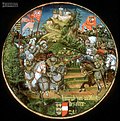 Henry I the Elder Henry I the Elder | 1158
Second son of Henry II and Theodora Komnene
31 August 1223
aged 64–65 | 13 January 1177
31 August 1223 | Duchy of Mödling | Richeza of Bohemia
1177
one child | Leopold gave his brother Henry the so-called Duchy of Mödling (title Henry used from 1205), which spanned from Liesing to Piesting and Bruck an der Leitha. Henry I and his descendants became mostly interested in the arts. |
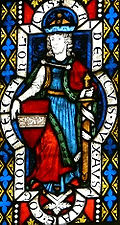 Frederick I the Catholic Frederick I the Catholic | 1175
First son of Leopold V and Helena of Hungary
16 April 1198
The Holy Land
aged 22–23 | 31 December 1194
16 April 1198 | Duchy of Austria | Unmarried | Left no children. |
 Leopold VI the Glorious Leopold VI the Glorious | 15 October 1176
Second son of Leopold V and Helena of Hungary
28 July 1230
San Germano
aged 53 | 16 April 1198
28 July 1230 | Duchy of Austria | Theodora Angelina
1203
seven children | |
 Henry II the Profane Henry II the Profane | 1208
First son of Leopold I and Theodora Angelina
29 November 1228
aged 19–20 | 31 August 1223
29 November 1228 | Duchy of Mödling | Agnes of Thuringia
29 November 1225
Nuremberg
one child | Nephew of Henry I, apparently succeeded him as ruler, preceding his cousin (Henry I's son). He is referenced as Heinricus iuvenis dux who died in 1227, [5] and Henrici de Medlico (Henry of Mödling). [6] |
 Henry III the Younger Henry III the Younger | 1182
Son of Henry I and Richeza of Bohemia
1236
aged 53–54 | 29 November 1228
1236 | Duchy of Mödling | Unmarried | After his death the duchy reverted to his cousin Gertrude, daughter of Henry II. |
 Frederick II the Quarrelsome Frederick II the Quarrelsome | 25 April 1211
Wiener Neustadt
Second son of Leopold I and Theodora Angelina
15 June 1246
Leitha
aged 35 | 28 July 1230
15 June 1246 | Duchy of Austria | Eudokia Sophia Laskarina Angelina
no children
Agnes of Merania
1229
no children | His troublesome marriages with no children opened a succession crisis in Austria. |
 Gertrude Gertrude | 1226
Daughter of Henry II, Duke of Mödling and Agnes of Thuringia
24 April 1288
aged 61–62 | 1236
4 October 1250 | Duchy of Mödling | Vladislaus of Bohemia
1246
no children
Herman VI, Margrave of Baden
1248
two children
Roman Danylovych
1252
one child | Heiress of Mödling. After her cousin's death in 1246, she was the first to claim the duchy. She was associated with her first two husbands. However, as Herman of Baden failed to defeat the opposition of Austrian nobility, her rule weakened substantially, giving them minimal control over the duchies. Her first refusal of a third marriage with the brother of William II of Holland, combined with the occupation of Austria by her cousin Margaret and Ottokar of Bohemia in 1252, halted her claims. Although she was even given a part of Styria in 1254, she did not forswear her claim; her territorial portion was taken away from her in 1267. |
15 June 1246
4 October 1250
1254–1267 | Duchy of Austria
(in only part of Styria in 1254–67) |
| Vladislaus of Bohemia | 1227
Son of Wenceslaus I of Bohemia and Kunigunde of Hohenstaufen
3 January 1247
Leitha
aged 19–20 | 15 June 1246
3 January 1247 | Duchy of Austria
(claimant as consort) | Gertrude
1246
no children |
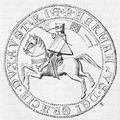 Herman VI, Margrave of Baden Herman VI, Margrave of Baden | c.1226
Son of Herman V, Margrave of Baden and Irmengard of the Palatinate
4 October 1250
aged 23–24 | 1248
4 October 1250 | Duchy of Austria
(claimant as consort) | Gertrude
1248
two children |
 Frederick I, Margrave of Baden Frederick I, Margrave of Baden | 1249
Alland
Son of Herman VI, Margrave of Baden and Gertrude
29 October 1268
Naples
aged 18–19 | 1254
1267 | Duchy of Austria
(claimant as heir; in only part of Styria) | Unmarried |
 Margaret Margaret | 1204
Daughter of Leopold I and Theodora Angelina
29 October 1266
Krumau am Kamp
aged 61–62 | 6 May 1252
29 October 1266 | Duchy of Austria
(from 1261 only in Krumau am Kamp) | Henry (VII) of Germany
29 November 1225
Nuremberg
two children
Ottokar II of Bohemia
11 February 1252
Hainburg an der Donau
(annulled 1261)
no children | Margaret and her husband, future King of Bohemia, invaded Austria in 1252 and were successfully proclaimed Dukes of Austria. After the annulment of their marriage, Margaret retired and Ottokar continued his rule until 1276, when he signed away his claims in Austria in favor of Rudolph of Habsburg. The matter would be settled with his defeat and death at the Battle on the Marchfeld (1278). |
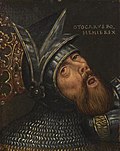 Premislaus Ottokar II of Bohemia The Iron and Golden King Premislaus Ottokar II of Bohemia The Iron and Golden King | 1233
Městec Králové
Son of Wenceslaus I of Bohemia and Kunigunde of Hohenstaufen
26 August 1278
Dürnkrut
aged 44–45 | 6 May 1252
1261 | Duchy of Austria
(claimant as consort) | Margaret
11 February 1252
Hainburg an der Donau
(annulled 1261)
no children
Kunigunda Rostislavna of Halych
25 October 1261
Pressburg
three children |
1261
November 1276 | Duchy of Austria |























